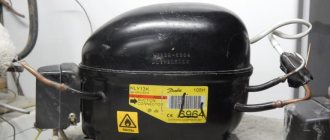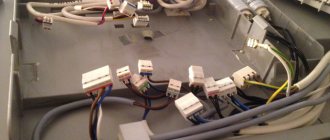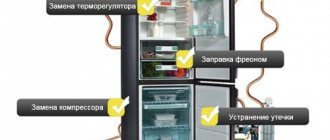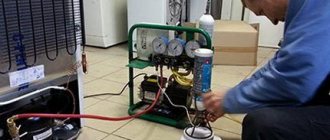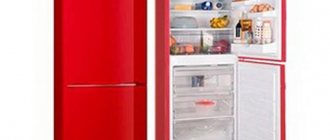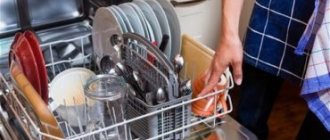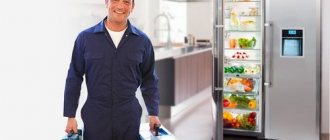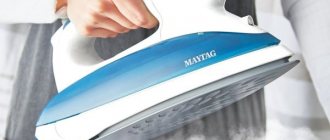Why does the refrigerator body get hot?
If, when you first started up the refrigerator, you noticed that its sides were heating up, don’t reproach yourself for a bad purchase and run to issue a return to the store.
Heating at the proper level is quite normal. The limit values are in the instructions. Usually the standard does not exceed 450C.
The reason for the increase in temperature is considered to be the operation of the heat exchanger. This happens as follows:
- the compressor drives freon through the pipes (it is also called refrigerant);
- under the influence of pressure, the refrigerant element turns from gas into liquid;
- when compressed, the gas heats up and, accordingly, heats the walls of the refrigerator from the outside, where the tubes pass;
- After this, freon, already in a liquid state, enters the evaporator and there it is processed again into gas. At this stage, the refrigerant takes heat from the refrigeration chambers, after which the cycle repeats.
The anti-condensation system also helps to heat the walls. It consists of heating tubes or tapes. They pass in the area of rubber seals on the doors, jumpers between the freezer and the refrigerator.
IMPORTANT! Under normal conditions, the refrigerator motor runs for 20 minutes to cool. and rests for the same amount of time. The back wall of the electrical appliance should only heat up while the motor is running.
When first started, the freezer operates under load until it gets cold inside. It turns out that the motor runs for more than 20 minutes, and all this time the back wall heats up.
What can cause excessive heating of the rear wall of the Atlanta
Refrigerators have a condenser located on the back wall. Like all other devices with a similar design, the grille gets hot for one of these “harmless” reasons:
- The refrigerator was defrosted. The motor runs until it gets cold, which means the rear wall tubes heat up;
- when a lot of food has been loaded into the chamber, the machine will freeze to the required temperature;
- food that was not completely cooled was placed in the chamber. The machine tries without interruption to cool it down;
- the door was often left open for a long time;
- ambient temperature is more than 300C.
The following factors for heat transfer loss that can be influenced should be listed:
- If the “super freeze” mode was accidentally activated. The essence of the option is the non-stop operation of the equipment until the user switches to another mode.
- A thick crust of ice has formed on the walls of the freezer. It interferes with proper heat exchange. In this case, you need to defrost it and turn it off for a day.
- According to the manufacturers' recommendations, when installed, there should be an “air cushion” of 5-7 cm around the refrigerator. This means that it cannot be placed close to walls and cabinets.
- The proximity to the battery or stove causes overheating of the rear wall.
- Warm air enters through the gap between the door and the chamber. The module sensor “sees” that the temperature is rising and causes the compressor to work above normal. This happens due to problems with the seal. If the rubber band is dirty, it should be washed with soapy water. If it becomes deformed, hot water helps restore its shape.
- Make sure the grilles at the back are clean. A thick layer of dust and fumes prevents the tubes from cooling. You can remove dirt using a vacuum cleaner or brush.
Reasons for heating the side walls of the refrigerator
Thermal energy is output through a capacitor, which is located on the rear side.
However, in modern devices it is often installed on the side. When the compressor is actively operating and distilling refrigerant, the condenser grilles become very hot. For this reason, the temperature on the side surface increases significantly. Another common reason is the presence of thermal energy sources nearby. For example, some owners place the refrigerator next to the gas stove. Also, too high a room temperature due to hot weather or heating leads to heating of the walls. The refrigerator should not be exposed to direct sunlight, and should not be installed next to a radiator.
Equipment often fails in the absence of normal heat exchange. It is not for nothing that manufacturers point out the need to place the refrigerator at a distance of at least 5 cm from walls and furniture. If possible, it is better not to place the device in a niche.
If the walls are hot all the time, and this has nothing to do with natural causes, it is better to contact a specialist. Most often, breakdowns result from improper operation or transportation of refrigeration equipment.
Factors not related to breakdowns
The main reasons for heating the refrigerator on the sides, which do not require the intervention of specialists:
- intensive operation of equipment after complete defrosting;
- full loading of the chambers with products, which leads to a sharp increase in temperature inside and increased operation of refrigeration equipment;
- placing hot foods in the refrigerator;
- activation of the fast freezing function;
- accumulation of a large amount of ice in the freezer, disrupting heat exchange in the device;
- opening the door too often or not closing it tightly;
- turning on the thermostat to maximum.
Why do the side walls of popular models heat up?
Manufacturers took into account the problem with heat transfer when the condenser is dirty, and decided to hide the grille under the cover in new models. The protection prevents dust from settling on the tubes and the appearance of cobwebs on the condenser.
Moreover, the authoritative ones, “Samsung”, decided to hide the heat exchanger grille on the sides. Therefore, during operation, it is these locations that heat up. This solution not only improved the aesthetic appearance of the equipment, but also increased its service life.
The reasons for heating the side walls are the same as in conventional refrigerators, in which the external compressor is located at the rear.
When to call a professional
ATTENTION! The engine will heat up in both new and faulty refrigerators. This is not a sign of a breakdown, but a normal condition of the equipment. It’s another matter if the food in the refrigerator begins to deteriorate as a result of excessive freezing in the cooling chamber or, conversely, the food remains at room temperature constantly.
When combined with overheating, these “symptoms” can result from:
- Refrigerant leaks.
- Incorrect operation of the temperature control sensor.
- Clogged capillary system.
- The start protection relay has burned out.
- The housing or one of the chambers has become depressurized.
- Damage to one of the evaporator parts.
There are many options and only a specialist can diagnose the essence of the problem. There is no need to fix the problem yourself.
Freon leak
Bleeding the refrigerant from the pipes causes the compressor to work without stopping. As a result, it becomes so hot that you can get burned by touching it. This is not a normal condition. In this mode, the equipment is not able to bring frost into the refrigerator.
This situation can arise in 2 cases:
- Corrosion destroyed the steel pipes of the circuit. It is through them that freon is transported through the refrigerator.
- The integrity of the body was damaged as a result of mechanical impact. For example, during defrosting, the ice was chipped with a sharp object and the camera was damaged.
Closure
Electrical appliances are sensitive to voltage surges. Interturn short circuit of the windings is a very real reason that the refrigerator motor heats up but does not start. In this case, constant clicks of the start-up relay will be heard, but there is no cold in the chambers.
Restoring functionality in the event of such a breakdown is quite a financially expensive undertaking.
The capillary tube is clogged
In this case, identifying the problem is easy. The “symptoms” of the problem are:
- Only the first row of the capacitor array is heated, the rest are cold;
- The freezer is heating up.
You can't deal with the blockage without special equipment. Therefore, it is necessary to call a specialist.
Thermal sensor failure
A breakdown of the electronic control unit (ECU) prevents the compressor from starting.
Here are 2 scenarios of how this happens:
- The ECU does not send a signal to turn on.
- The temperature sensor cannot determine that the temperature of the chambers is normal, so the command to turn off the engine is not received.
Due to a malfunction in the program, the motor may wear out or not start at all. In both cases the compressor will overheat.
A refrigerator is a kind of heat pump that pumps thermal energy from the inside to the outside. This system actively uses the properties of freon. This gas is pumped through the compressor tubes. As a result, under normal conditions the refrigerator should take 20 minutes. work, and the next 20 minutes. the grate on the back wall is cooling down. In models from other top manufacturers, this grille is hidden in the sides of the body. Therefore, heat is felt in this area.
There are factors that can cause the compressor to work longer than expected: starting with a hot pan placed in the chamber and ending with the incorrect location of the equipment itself. At the same time, the back wall of the refrigerator gets very hot (more than 450).
The condition of the products in the chamber will help determine the breakdown. They should not freeze, but be cooled in a regular chamber and frozen in the freezer. Operating instructions should be followed so as not to disturb the heat exchange of the compressor. If necessary, without delay, call a specialist. The main thing is to understand that the back and side walls of the refrigerator will heat up both in working and in malfunctioning states. The instructions usually indicate the maximum permissible values.
Video: heating and noise of the refrigerator
M.Service: Refrigerator. Heating and noise.
Watch this video on YouTube
Video: the compressor is very hot and there is no cold
The compressor is very hot and there is no cold. Refrigerator repair.
Watch this video on YouTube
Do you want to understand better than others?
- Why does the refrigerator get very hot and how to fix it - Refrigerators are designed to cool food to temperatures ranging from a few degrees Celsius to negative values. In any case, this is lower than the environment. Principle…
- Why does the side wall of my LG refrigerator get hot? — Where the refrigerator can get warm The most common places where heating can be observed: the back grill of the refrigerator; compressor; side walls. Majority…
- Why does the back wall of the Biryusa refrigerator freeze - Causes of the problem When evaporation from products stored in the chamber works correctly, the condensate freezes when the motor is running and then melts. When the compressor turns off, the liquid...
- The refrigerator constantly works and does not turn off, we find and eliminate the reasons. Why does the refrigerator constantly work and not turn off? Problems and solutions - What is the operating cycle of a refrigerator? This indicator can be expressed by the following formula: equipment operating time + its rest time. For example, the period...
- Why does the refrigerator click? The main reasons why a refrigerator cracks or clicks during operation - Why does a refrigerator make strange sounds? When refrigerators are operating, it is not uncommon for strange sounds to appear, which should definitely alert the owner. Certainly,…
Where can a refrigerator heat up?
- 3.1. Room temperature
- 11.1. Related articles:
The most common places where heating can occur are:
- refrigerator rear grille;
- compressor;
- side walls.
Most people who use older models of refrigerators and some modern ones (Biryusa, Atlanta) have noticed that the unit is hottest in the area of the rear grille. This is the condenser, the section of piping where the refrigerant is condensed from a gaseous state to a liquid before entering the compressor.
During this process, a large amount of heat is generated, so the pipeline is designed in the form of a radiator and is located at the rear of the device. Such refrigerators are also called devices with a drip system. They periodically manually or automatically turn on the defrost mode to remove frost and ice.
To do this, there is a drain hole on the partition at the back of the chamber leading to the pan.
Reference. New technologies for freezing and cooling methods have made it possible to get rid of the bulky radiator grille. Manufacturers now place it partly in the walls of the case and in the form of a small radiator near the compressor, where it is blown by force using a small fan. This applies to devices with dry freezing - No Frost.
Most manufacturers of popular refrigeration equipment (Samsung, Hyer, Kandy, Indesit) produce such models. The principle of cooling is to blow cooled air over the food. Nord and Haier companies produce equipment for both systems.
M.Service: Refrigerator. Heating and noise.
Watch this video on YouTube
Dry freezers do not accumulate frost inside because the air flow picks up the moisture and carries it away from the work area. The only place where condensation occurs is the area at the ends of the door walls, where moist air from the room enters when the door of the refrigerator or freezer is opened. Therefore, if the refrigerator body heats up in the area of the freezer, then there is nothing abnormal here.
To evaporate the accumulated condensate, a part of the evaporator pipeline is laid on the side wall in the place where the rubber seals are located, as a result of which this part of the device begins to heat up, evaporating the collected moisture.
Most often, in refrigerators with a top-mounted freezer, it is observed that it heats up between the chambers. The reason is the same - removing condensation from cold air when opening the freezer door.
Why are the walls of the refrigerator always hot?
If the housing is constantly hot, the unit operates at full power and does not have time to cool down. This happens in working and faulty refrigerators. There are several reasons that are not related to equipment failures:
- After defrosting or turning on the new device for the first time, it reaches the required temperature within 1-3 hours and does not turn off. To make this process go faster, it is recommended not to load products into the chamber, but to let the equipment run idle.
- When the “fast freezing” mode is set, the compressor works at full capacity.
- If the temperature regulator is set to maximum, the motor runs non-stop. This is not recommended; setting the regulator to medium values is considered optimal.
- It's hot inside. At temperatures from +30°C and above, heat exchange becomes difficult and the load on the compressor increases.
- The refrigerator is installed next to a heat source (stove, radiator, etc.). External heating impairs heat transfer and leads to overheating of the motor.
- The household appliance is moved close to the wall, which causes it to heat up. If the radiator grille is located on the back wall of the equipment, there must be a gap of at least 7 cm between it and the wall.
- If a large batch of products is loaded at the same time, the compressor tries to cool it to the set temperature and does not turn off for a long time. To avoid this, the refrigerator is filled in small batches.
- When hot or cold food is placed in the device, the motor tries to catch up with the cold and runs for a long time.
- Normal heat exchange is disrupted when metal, glass or ceramic containers are leaned against the walls of the device.
- The reason may be the frequent and long opening of the refrigerator door. To cool the warm air entering the chamber, the motor works harder.
- If the unit has not been defrosted for a long time, and ice has formed in it, preventing normal heat exchange, the compressor operates at full strength. To correct the situation, the device is defrosted.
- When the grille in older models, located at the rear, is dirty, it interferes with heat transfer. As a result, the case overheats to high temperatures. The grill must be periodically cleaned of accumulated dirt.
These reasons are not critical and can be easily eliminated on your own. To avoid them, follow the rules for operating household appliances.
If the body of the unit is constantly heating up and its temperature exceeds +45°C, while the chamber is warm and food begins to deteriorate, this indicates a technical malfunction.
Advice. Before troubleshooting, it is recommended to study the operating instructions for the device. It describes the main possible problems.
The reasons why the unit heats up but does not freeze are the following:
- Seal wear. If it is worn or damaged, the refrigerator door will not fit tightly against the body. Warm air constantly enters the chamber, and the compressor runs continuously. To check, insert a sheet of paper between the door and the body. If it falls out, the part should be replaced. This can be done independently or with the help of a specialist.
- Thermostat failure. The faulty part sends incorrect signals to the compressor. It does not work properly and overheats. To fix the problem, replace the thermostat with a new one.
- Freon leak. When a refrigerant leak occurs, the motor runs continuously, causing it to overheat. To eliminate the malfunction, find the leak, weld it and refill the system.
- Clogged capillary system. Oil clots clog the cooling system, and freon cannot move normally. This increases the load on the motor and leads to overheating. To correct the situation, the oil and refrigerant in the system are changed.
- Compressor failure. If an interturn short circuit of the windings or a short circuit occurs, the motor begins to warm up, but does not start. At the same time, clicks of the start-up relay are heard. To fix the problem, the compressor is replaced.
- Failure in the control unit. When the control unit fails, the compressor begins to behave unpredictably. In this case, an error code may appear on the display. To correct the situation, the system is reflashed.
All elements and nodes are interconnected. When one of them fails, it affects the operation of the entire system.
Why do the partitions between the chambers heat up?
First, understand the structure of your equipment or look at the instructions. In Soviet-made refrigerators, there was a grille on the back wall - a condenser. When the engine started running, the rear grille would heat up and then cool down.
In modern two-compartment refrigerators, the condenser tube is located inside the side wall, which leads to its heating. Why is this done? During operation of the freezer, a subzero temperature is created; cold air finds its way out where the door meets the body. If the room temperature is high, then condensation may form on the walls, which over time leads to corrosion and mold on the seal.
Condenser tubes located at the rear or sides allow moisture to evaporate.
This is how the system works. For what reasons do the walls of a refrigerator (brand) get too hot:
- The room is too hot, poor ventilation. For normal operation of the refrigerator, the distance between the body and the furniture should be at least 5-7 cm.
- The equipment has recently been defrosted. Then it will take time for cooling to occur and the temperature to return. The same thing happens after loading warm products into the compartments.
- The silicone (rubber) seal in the freezer heats up, which causes the door to fit tightly to the body. As a result, cold air does not leak through to cool the walls.
In some refrigerators (Nord, Indesit), the partition between the refrigerator and freezer compartments is heated. This is a normal phenomenon, because moisture most often forms here. It is recommended to take care of the side walls of the equipment; if they are always dry, then you will not be in danger of breaking.
Back wall
The back wall always gets hot, which is due to the operating principle of the refrigerator. But if the grate is not just hot, but red-hot (t above 45 °C), this is a reason to worry.
Refrigerator condenser
You need to check the grille for dirt. Dust and fumes interfere with heat transfer, which, in turn, reduces the efficiency of the refrigerator. Cleaning must be performed. To do this, you need to disconnect the device from the network, move the equipment away from the wall and vacuum the grille or remove the deposits with a brush. When doing this, care must be taken not to damage the fragile condenser tubes.
If this does not help, you should check the condition of the temperature sensor. Perhaps it is set to the maximum position, which led to increased load. As a result of the increased thermal output, the grate temperature naturally became higher.
Clean the back grill of the refrigerator
Don't discount the ambient temperature either. In hot summers at temperatures of 30 °C and above, heat exchange becomes difficult, which creates a greater load on the compressor.
If all the situations listed above did not help resolve the problem, you need to call a technician for a full diagnosis.
Refrigerator condenser gets hot
During normal operation, the heating temperature of the grate should not exceed 45 degrees. If the condenser is too hot, then check:
- Presence of dust and oil stains. Dirt makes it difficult to transfer heat, so the grate must be kept clean. Turn off the equipment, move the case away from the wall and clean the condenser from dust.
- Enabling the Super Freeze function. In mechanical models, this mode causes an overload of the motor-compressor, so the grille constantly heats up.
There is also a possibility of a coolant gas leak. But only a diagnostic technician can detect the problem.
Why does the compressor get hot?
The compressor of an ordinary household refrigerator operates under rather extreme conditions. In order to ensure the temperature inside the refrigeration chamber is about +5°C, and in the freezer even lower - about -20°C, the compressor performs the work of compressing the refrigerant under high pressure. The compressed freon is heated to a high temperature, giving part of it to the compressor, and leaving the rest of the heat in the lattice heat exchanger. This is also added to the heat generated by the passage of electric current through the windings of the compressor motor. The combination of these factors gives the answer to the question: why does the refrigerator compressor heat up? The normal operating temperature of the compressor is 50-60°C, and the maximum permissible temperature is up to 90°C. As wear occurs, the operating temperature rises. If you touch the metal surface of a heated compressor with an unprotected hand, you can get burned.
But this is normal heating of the compressor and does not require intervention.
If the compressor heats up to a temperature that triggers the protective relay, and even does this in a short period of time of several minutes, then we are most likely talking about an interturn short circuit or damage to the motor winding. The only solution in this case is to completely replace the compressor.
In the comments (see below) the question is often asked: why does the refrigerator get hot in the heat. Briefly: in hot weather it is more difficult for a refrigerator to remove heat from the inner chamber to the outside and this is the norm, but with a caveat. There are different climate classes of refrigerators; check at what temperature conditions your refrigerator can be operated.
